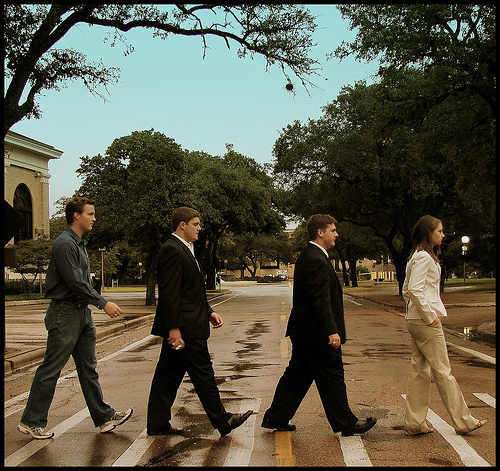Education Quality, International, Required, Science, Universities & Colleges - Written by Wired Academic on Thursday, August 16, 2012 6:34 - 0 Comments
Training Engineers 101: How South Korea Outpaces The US In Cranking Out Degreed Engineers

![]() Photo Credit: sarowen via Compfight
Photo Credit: sarowen via Compfight
By Michael Alison Chandler, The Hechinger Report
DAEJON, South Korea—Any eighth-grader who wonders if anyone actually uses algebra should ask Hyungtae Lee, an electrical engineer who writes algorithms to build computers with the power of human sight.
It’s a skill he learned first here in South Korea, where undergraduate students are five times more likely to major in engineering than their counterparts in the United States.
U.S. universities and companies often look abroad for students and workers to fill positions because not enough Americans have the necessary skills or training. To help meet the demand, President Obama has announced a goal to train 1 million more graduates over the next decade in engineering and related fields.
At a White House science fair in February, he told the young contestants, “You’re not just trying to win a prize today, you are getting America in shape to win the future. You are making sure we have the best, smartest, most skilled workers in the world, so that the jobs and industries of tomorrow take root right here.”
South Korea far outpaces the United States in the percentage of young adults with college degrees—63 versus 41 percent—and its K-12 students routinely outperform U.S. children on international assessments. While South Korean leaders have begun to fret that their young people—raised among skyscrapers and affluence—are pursuing higher-paying jobs outside technical fields, the workforce remains highly tech-savvy: One in four South Korean college students majors in engineering, compared to one in 20 in the U.S.
The reason for the glut of engineers can be summed up easily: South Korea’s education system was designed to produce them.
South Korea’s school system—unlike the American system—is centralized and regulated according to economic demands. The national ministry of education and the ministry of science and technology are one and the same, and the president’s vision for economic development can have immediate reverberations in schools.
For decades, South Korea’s strategy for success has been to outsmart its more powerful neighbors. In a country with few natural resources, the next technological breakthrough is sometimes referred to in Korean as the next “meal.”
To transform a poor country of mostly illiterate farmers into a high-tech powerhouse, they had to start at the beginning—with compulsory elementary education and a standardized curriculum.
Lee, who grew up in Seoul, learned the same math and history lessons year to year as students his age in smaller cities or villages throughout South Korea.
A consistent and strong foundation for every child paved the way for South Korea’s college enrollment to explode a few decades later. Between 1980 and 2008, the number of college students increased from 647,500 to 3.6 million. More than 80 percent of high-school graduates go on to higher education, one of the highest rates in the world.
The United States is moving toward a more consistent curriculum, with widely adopted academic standards that aim to make American students more internationally competitive. But a tradition of tracking students by ability and localized decision-making about learning standards has led to uneven results. Not everyone who graduates from high school is ready for college-level work, let alone the advanced math and science course work required for engineering. The proportion of students in Maryland’s public university system who have to take at least one remedial course ranges from 20 to 50 percent, depending on the campus.
The South Korean government also closely regulates higher education, and historically set enrollment quotas for different programs and types of schools to reflect the economy’s needs. Such regulation would be unwelcome in the United States, said Joseph Helble, dean of the engineering school at Dartmouth College. American universities pride themselves on their freedom and on nurturing independent thinking in their students.
“But if you need to rapidly develop technology and train many people, a tightly controlled system works,” he said.
To entice the best students into science and tech fields, the South Korean government also created a flagship university—Kaist, or the Korea Advanced Institute of Science and Technology.
The nationally sponsored school—similar to military academies in the United States, but dedicated to furthering South Korea’s economy—showcased engineering as a prestigious profession fundamental to the nation’s success starting in 1971.
South Koreans who had gone abroad to study were lured back with handsome salaries to teach. And the best students in the country were recruited with the promise of free tuition and an exemption from mandatory military service, in return for a promise to work in a government lab for three years after graduation. Over the years, Kaist graduates have filled government research institutes and top jobs at companies like Samsung and Hyundai.
Admission became so prized that parents in the countryside would wave banners and host a banquet for the village if their son or daughter was accepted.
Lee, now 33, remembers watching a popular television drama called “Kaist” about life and love in the laboratory when he was a teenager, and imagining himself there. “I never missed an episode,” he said.
He earned a master’s degree there after finishing first in his undergraduate class at Sogong University in Seoul.
On a warm spring afternoon, the grassy fields at the 300-acre campus south of Seoul were deserted but the labs were full. Students were designing exercise equipment for people with Alzheimer’s disease, studying the olfactory systems of fruit flies, and fine-tuning an electric bus that recharges wirelessly as it drives over electric strips embedded in the road.
Kaist president Suh Nampyo, a former mechanical engineering professor and department head at the Massachusetts Institute of Technology, said he wants to make the school not just the best in South Korea, but one of the top 10 science universities in the world. (Kaist was 94th on the 2011-12 Times Higher Education world ranking, up from 132 in 2007).
He has launched a series of reforms to stir competitiveness, offering all-English instruction and overhauling the admissions system. International applications are up, particularly from Southeast Asia and Eastern Europe.
The increasing quality of universities such as Kaist in other countries means the United States has to compete increasingly for international students, making it all the more important to build a better pipeline of talent domestically.
“It’s not at all obvious anymore that we can just turn on the spigot and all the talented people will come here,” said Debra W. Stewart, president of the Council of Graduate Schools in Washington D.C.
Nor can it be assumed they’ll stay here, industry leaders say, thanks to politically volatile immigration policies and new opportunities in emerging economies abroad.
When Lee completes his Ph.D. in 2013, he would like to work for Google. But he’s also interested in going back home to work for a Korean company or university.
“It all depends on the offers I get,” he said.
This story was produced by The Hechinger Report, a non-profit, independent journalism publication housed at Columbia University’s Teacher’s College. It also appeared in The Washington Post on July 17, 2012.
Campus Buzz
We welcome Tips & Pitches
Latest WA Original Features
-
“Instreamia” Shakes Loose Moss By Launching Spanish Language Mini-MOOC
-
Jörn Loviscach: A German Math Teaching Sensation Emerges On YouTube & Udacity
-
Open University Enters Battle Of The MOOCs, Launches “FutureLearn”
-
Alvaro Salas As A Case Study In Crowd-Funding An Ivy-League Education
-
Jonathan Mugan: How To Build A Free Computer Within A Computer For Your Child
Paul Glader, Managing Editor
@paulglader
Eleni Glader, Policy Editor
Elbert Chu, Innovation Editor
@elbertchu
Biagio Arobba, Web Developer
@barobba
Contributors:
Michael B. Horn
@michaelbhorn
Derek Reed
@derekreed
Annie Murphy Paul
@AnnieMurphyPaul
Frank Catalano
@FrankCatalano
Ryan Craig
@UniVenturesFund
Jonathan Mugan
@JMugan
Terry Heick
@TeachThought
Alison Anderson
@tedrosececi
Ravi Kumar
@ravinepal

The Pulitzer Prize winning investigation newsroom digs into for-profit education.
-
Most Viewed
- Inside Ashford University: A former staffer talks to WiredAcademic
- Infographic: A History Of Information Organization From Stone-Age To Google
- Davos: 12-Year-Old Pakistani Prodigy Girl Talks About Her Online Learning
- Open University Enters Battle Of The MOOCs, Launches "FutureLearn"
- Pearson Llc + Google Expands LMS Business With "OpenClass" System
-
MARKET INTRADAY SNAPSHOT
- Education & Tech Companies We Follow
| APEI | 40.20 |  -0.17 -0.17 |  -0.42% -0.42% | ||
| APOL | 19.01 |  +0.33 +0.33 |  +1.77% +1.77% | ||
| AAPL | 460.16 |  -6.43 -6.43 |  -1.38% -1.38% | ||
| BPI | 10.74 |  -0.09 -0.09 |  -0.83% -0.83% | ||
| CAST | 0.11 |  +0.01 +0.01 |  +10.00% +10.00% | ||
| CECO | 4.08 |  -0.02 -0.02 |  -0.49% -0.49% | ||
| COCO | 2.40 |  -0.02 -0.02 |  -0.83% -0.83% | ||
| CPLA | 32.03 |  -0.41 -0.41 |  -1.26% -1.26% | ||
| DV | 30.69 |  +0.36 +0.36 |  +1.19% +1.19% | ||
| EDMC | 4.03 |  +0.07 +0.07 |  +1.77% +1.77% | ||
| ESI | 18.34 |  +0.04 +0.04 |  +0.22% +0.22% | ||
| GOOG | 792.89 |  +5.07 +5.07 |  +0.64% +0.64% | ||
| LINC | 6.20 |  +0.06 +0.06 |  +0.98% +0.98% | ||
| LOPE | 25.03 |  +0.36 +0.36 |  +1.46% +1.46% | ||
| PEDH | 0.45 |  0.00 0.00 |  +0.00% +0.00% | ||
| PSO | 18.51 |  -0.27 -0.27 |  -1.44% -1.44% | ||
| SABA | 8.61 |  -0.16 -0.16 |  -1.82% -1.82% | ||
| SCHL | 30.87 |  +0.46 +0.46 |  +1.51% +1.51% | ||
| STRA | 51.95 |  -1.54 -1.54 |  -2.88% -2.88% | ||
| WPO | 414.41 |  +5.35 +5.35 |  +1.31% +1.31% |
Domestic, For-Profit, Gainful Employment, Infographics, Personalized Learning, Private, Public, Required, Universities & Colleges - Jan 31, 2013 6:09 - 0 Comments
Infographic: To Get A Degree Or Not To Get A Degree? Here Is An Answer
More In For-Profit
- Ryan Craig: American Clampdown Forcing Forlorn For-Profit Colleges To Look Abroad
- How For-Profit Colleges Major In Marketing & Fail Education
- Infographic: A Graphical Profile Of Today’s Online College Student
- Infographic: A Comparison Of For-Profits v. Non-Profit Online College Data
- Opinion: How “Shareholder Value” Is Destroying For-Profit, Career Colleges
Cost of Education Domestic Education Quality Ethics For-Profit Friend, Fraud, or Fishy Gainful Employment Graduation Rates Legislation Minorities Opinion Recruitment Regulatory Required Retention Rates Student Loans Universities & Colleges
MOOCs, Required, Technology - Feb 16, 2013 10:04 - 0 Comments
MOOC Monitor: Must Reads This Week
More In Technology
- Infographic: Rise of the MOOCs
- Smart Cities Part II: Why DC Is The Planetary Hub Of Online Learning
- Five Questions: Polling EdTech Startup UnderstoodIt’s Liam Kaufman
- Infographic: The Future of Higher Education
- Anne Collier: Study Shows eBooks Gaining Larger Share & Boosting Overall Reading Habits
Domestic K-12 Parents Reading / Literature Required Technology
Charter, Cost of Education, Domestic, Education Quality, Friend, Fraud, or Fishy, K-12, Minorities, Regulatory, Required - Feb 7, 2013 12:23 - 0 Comments
Should For-Profit Companies Manage K-12 Schools? A Skeptical Review
More In Friend, Fraud, or Fishy
- A Letter To Sen. Tom Harkin About For-Profit Charter Schools
- Ryan Craig: American Clampdown Forcing Forlorn For-Profit Colleges To Look Abroad
- Opinion: The Problem With Deceptive Degree Aggregators In The Search For Online Courses & Degrees
- How For-Profit Colleges Major In Marketing & Fail Education
- Infographic: A Comparison Of For-Profits v. Non-Profit Online College Data
Cost of Education Domestic For-Profit Friend, Fraud, or Fishy Graduation Rates Infographics Recruitment Required Universities & Colleges


Leave a Reply